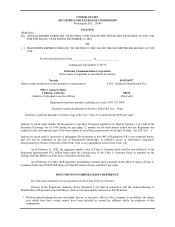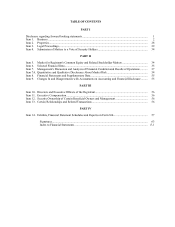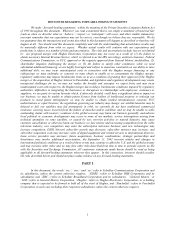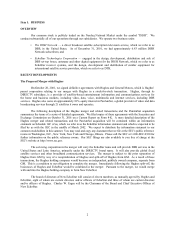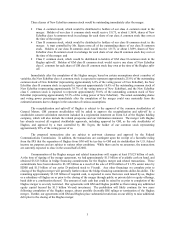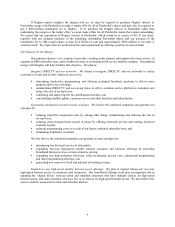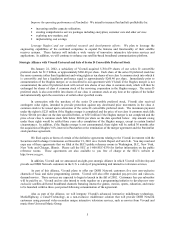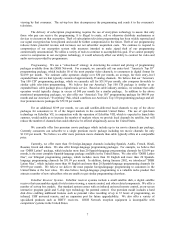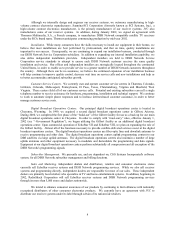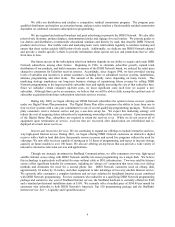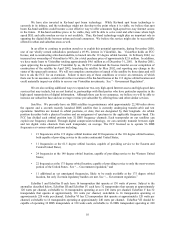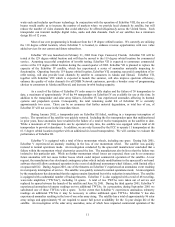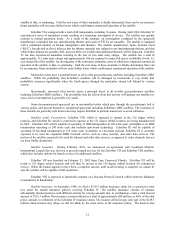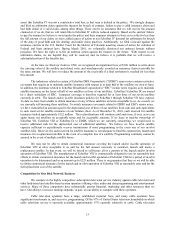Dish Network 2001 Annual Report Download - page 5
Download and view the complete annual report
Please find page 5 of the 2001 Dish Network annual report below. You can navigate through the pages in the report by either clicking on the pages listed below, or by using the keyword search tool below to find specific information within the annual report.3
Three classes of New EchoStar common stock would be outstanding immediately after the merger:
• Class A common stock, which would be distributed to holders of our class A common stock in the
merger. Holders of our class A common stock would receive 1/0.73, or about 1.3699, shares of New
EchoStar class A common stock in exchange for each share of our class A common stock they own at
the time of the merger;
• Class B common stock, which would be distributed to holders of our class B common stock in the
merger. A trust controlled by Mr. Ergen owns all of the outstanding shares of our class B common
stock. Holders of our class B common stock would receive 1/0.73, or about 1.3699, shares of New
EchoStar class B common stock in exchange for each share of our class B common stock they own at
the time of the merger; and
• Class C common stock, which would be distributed to holders of GM class H common stock in the
Hughes split-off. Holders of GM class H common stock would receive one share of New EchoStar
class C common for each share of GM class H common stock they own at the time of the Hughes split-
off.
Immediately after the completion of the Hughes merger, based on certain assumptions about a number of
variables, the New EchoStar class A common stock is expected to represent approximately 25.6% of the outstanding
common stock of New EchoStar (representing approximately 6.0% of the voting power of New EchoStar), the New
EchoStar class B common stock is expected to represent approximately 16.4% of the outstanding common stock of
New EchoStar (representing approximately 38.7% of the voting power of New EchoStar), and the New EchoStar
class C common stock is expected to represent approximately 58.0% of the outstanding common stock of New
EchoStar (representing approximately 55.3% of the voting power of New EchoStar). The actual outstanding shares
and voting power percentages immediately after the completion of the merger could vary materially from the
estimated amounts due to changes in the outcomes of various assumptions.
The recapitalization and split-off of Hughes is subject to the approval of the common stockholders of
General Motors. GM common stockholders will be asked to approve the recapitalization and split-off by a
stockholder consent solicitation statement included in a registration statement on Form S-4 of the Hughes holding
company, which will also include the related prospectus and our information statement. The merger with Hughes
has already received all required stockholder approvals, including approval by GM, as the sole stockholder of
Hughes, and approval by a trust controlled by Mr. Ergen, the holder of our common stock representing
approximately 90% of the voting power of us.
The proposed transactions also are subject to anti-trust clearance and approval by the Federal
Communications Commission. In addition, the transactions are contingent upon the receipt of a favorable ruling
from the IRS that the separation of Hughes from GM will be tax-free to GM and its stockholders for U.S. federal
income tax purposes and are subject to various other conditions. While there can be no assurance, the transactions
are currently expected to close in the second half of 2002.
Consummation of the Hughes merger and related transactions will require at least $7.025 billion of cash.
At the time of signing of the merger agreement, we had approximately $1.5 billion of available cash on hand, and
obtained $5.525 billion in bridge financing commitments for the Hughes merger and related transactions. These
commitments have been reduced to $3.325 billion as a result of the sale of $700 million of 9 1/8% senior notes by
EDBS and $1.5 billion of our series D preferred stock to Vivendi. Any other financings we complete prior to
closing of the Hughes merger will generally further reduce the bridge financing commitments dollar-for-dollar. The
remaining approximately $3.325 billion of required cash, is expected to come from new cash raised by us, Hughes
or a subsidiary of Hughes on or prior to the closing of the merger through public or private debt or equity offerings,
bank debt or a combination thereof. The amount of such cash that could be raised by us prior to completion of the
Hughes merger is severely restricted. Our agreements with GM and Hughes prohibit us from raising any additional
equity capital beyond the $1.5 billion Vivendi investment. The prohibition will likely continue for two years
following completion of the Hughes merger, absent possible favorable IRS rulings or termination of the Hughes
merger. Further, our agreements with GM and Hughes place substantial restrictions on our ability to raise additional
debt prior to the closing of the Hughes merger.

